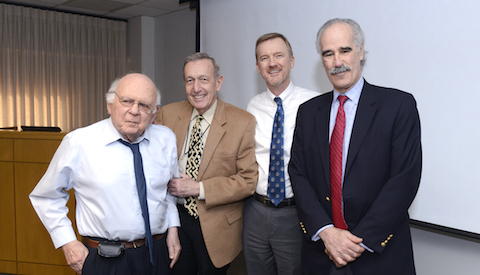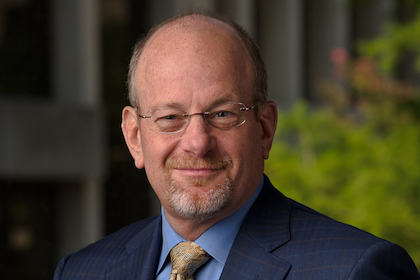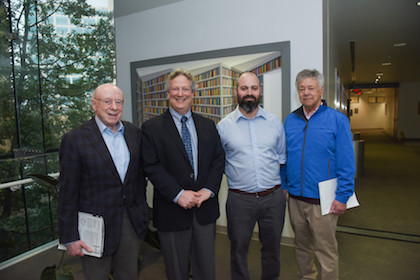Harvard investigator joins UTSW colleagues in diabetes battle recounting
By Ron Durham

Dr. David M. Nathan, Director of the General Clinical Research Center and the Diabetes Center at Massachusetts General Hospital, describes diabetes as the “biggest epidemic in the world.” Visiting the UT Southwestern Medical Center campus on Feb. 12 as an honored guest speaker, he recounted the decades-long journey in treating the disease that now affects an estimated 30 million people in America and 350 million more worldwide.
Dr. Nathan, who also serves as a Professor of Medicine at Harvard Medical School, was presented as the Leonard L. Madison, M.D., Visiting Professor in Diabetes, Endocrinology, and Metabolism at the Internal Medicine Grand Rounds, and later at the Division of Endocrine Grand Rounds.
“We have the biggest epidemic in the world and we don’t know how to treat it,” Dr. Nathan said during his Internal Medicine lecture, “Trials and Tribulations: Progress and Controversies in Diabetes, 2016.” Dr. Nathan’s afternoon presentation was titled “Have We Cured the Complications of Type 1 Diabetes: What’s Left?”
The introduction of insulin in the early 1920s, either by multiple injections or pump therapy, was a major breakthrough in the treatment of type 1 diabetes. By 2009, occurrences of blindness, which once affected 30 percent of diabetic patients, had dropped to just 1 percent. Kidney failure and amputation of limbs, previously as high as 22 percent and 12 percent respectively, were reduced to 1 percent also.
“With the introduction of insulin, [type 1] diabetes moved from an acutely fatal disease to a chronic degenerative disease,” Dr. Nathan said. “But we now had to address downstream conditions and complications, which had not been recognized when all patients had died within months of their diagnosis.”
In 1977, the New England Journal of Medicine published a positional letter on addressing diabetes written by, among others, pre-eminent UT Southwestern clinicians and researchers that included Dr. Daniel Foster, Professor of Internal Medicine; the late Dr. Madison, who died in 2014; as well as the late Dr. Marvin Siperstein, a noted University of California, San Francisco endocrinologist who earlier served as a UT Southwestern faculty member. Dr. Siperstein, who died in 1997, was a cholesterol metabolism pioneer whose campus lectures sparked the interest of many students, trainees, and young faculty members, including Drs. Joseph Goldstein and Michael Brown, who would go on to win the 1985 Nobel Prize in Physiology or Medicine for their discovery of the basic mechanism of cholesterol metabolism.
The 1977 letter challenged diabetes researchers and clinicians to help prove that blood glucose levels of patients with diabetes could be controlled in a manner that was both safe for patients and that could lead to a decrease in complications. Several years later, self-monitoring of blood glucose was developed, allowing the NIH to institute the Diabetes Control and Complications Trial (DCCT). When the positive results were eventually presented at a meeting of the American Diabetes Association, the central role of the group’s challenge was acknowledged.
Dr. Nathan, as well as UT Southwestern researchers, provided leadership in the DCCT effort in the 1980s and in the later Epidemiology of Diabetes Interventions and Complications (EDIC) trial. The local cadre of both studies were greatly impacted by the efforts of Dr. Philip Raskin, Professor of Internal Medicine, and Suzanne Strowig, faculty associate in Internal Medicine. These investigations, and their findings, remain the most highly cited diabetes research trials ever.
Today’s solutions and emerging technologies for type 1 diabetes include mechanical artificial pancreases that provide real-time feedback to deliver insulin or glucagon as needed. Dr. Nathan has been experimenting with this technology for the past six years.
The Diabetes Prevention Program, funded by the National Institute of Diabetes and Digestive and Kidney Diseases and conducted at 25 centers nationwide, is a landmark trial started in 1996 which showed that lifestyle changes or metformin can effectively delay type 2 diabetes in a mounting and diverse population of overweight or obese people in America.
After decades of research and clinical trials, Dr. Nathan says there remains an inexorable link between type 2 diabetes and body weight. And even a moderate amount of weight loss is beneficial.
“Some people say ‘I’m never going to lose 50 pounds’ so they just give up,” Dr. Nathan said. “We have found that for every kilogram lost – every 2.2 pounds – the onset of diabetes decreases by 16 percent. Lose another kilogram and it decreases by another 16 percent. So people need to try. Every little bit helps.”
The fight against diabetes has produced many debates, such as the pros and cons of high fructose corn syrup vs. regular sugar. While he admits to minute differences between the two, Dr. Nathan believes such arguments largely miss the mark and are of little merit.
“I find it a distraction,” Dr. Nathan said. “The sugar type pales in comparison to how much we eat – our overall caloric intake. It comes down to exercising and reducing the amount of calories consumed.”
Dr. David Johnson, Chairman of Internal Medicine at UT Southwestern, agreed.
“Typically, type 2 diabetes is seen later in life and seems to be related to obesity,” he said.
Dr. Johnson said obesity and type 2 diabetes can also be closely related to a region’s economic status. “Throughout the world, as a country’s economy improves the population’s caloric intake increases,” he said.
Dr. Perry Bickel, Chief of the Division of Endocrinology in the Department of Internal Medicine and host of the Endocrine Grand Rounds, said he is encouraged by the advances in diabetes control.
“I’m encouraged, absolutely,” Dr. Bickel said. “How well we control diabetes matters. We save eyes, kidneys, and limbs with better control. We’re developing better and better tools, like the artificial pancreas, but at some point what we need is an affordable way to achieve near normal control for a larger group of people. This is not just a U.S. problem, it’s a worldwide problem – particularly type 2 diabetes.”
Dr. Nathan said that achieving affordable control mechanisms for a greater percentage of those suffering from diabetes is a primary goal for everyone involved in diabetes research.
“Reducing the cost of therapy and making it accessible to all remain our overarching goals,” Dr. Nathan said.
###
Dr. Bickel, Associate Professor of Internal Medicine, holds the Daniel W. Foster, M.D., Distinguished Chair in Internal Medicine.
Dr. Brown, Director of the Erik Jonsson Center for Research in Molecular Genetics and Human Disease, is a Regental Professor who holds the W.A. (Monty) Moncrief Distinguished Chair in Cholesterol and Arteriosclerosis Research, and the Paul J. Thomas Chair in Medicine.
Dr. Foster holds the John Denis McGarry, Ph.D., Distinguished Chair in Diabetes and Metabolic Research.
Dr. Goldstein, Chairman of Molecular Genetics, is a Regental Professor who holds the Julie and Louis A. Beecherl, Jr. Distinguished Chair in Biomedical Research, and the Paul J. Thomas Chair in Medicine.
Dr. Johnson holds the Donald W. Seldin Distinguished Chair in Internal Medicine.
Dr. Raskin holds the Clifton and Betsy Robinson Chair in Biomedical Research.



